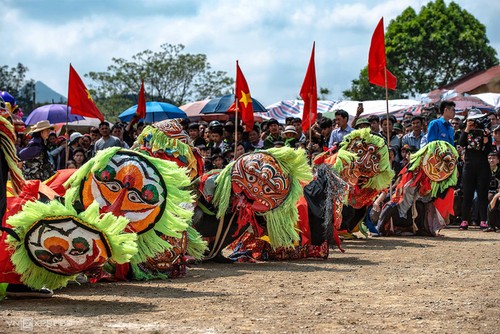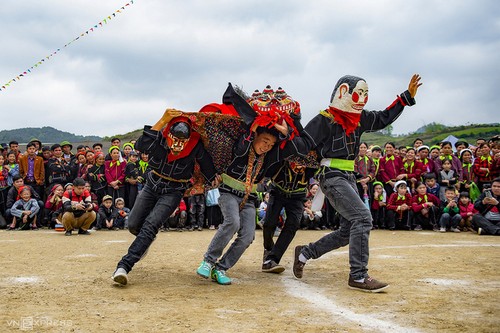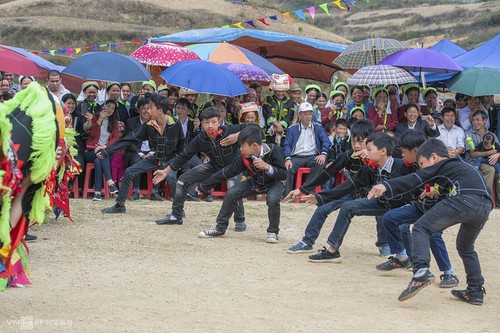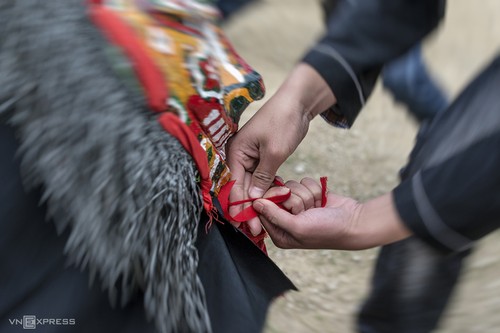 Tay and Nung people believe that, in the spring and festival seasons, if visitors haven’t see colorful lion heads and heard drums and gongs, they haven’t yet enjoyed the full festive atmosphere of Lang Son. Tay and Nung people believe that, in the spring and festival seasons, if visitors haven’t see colorful lion heads and heard drums and gongs, they haven’t yet enjoyed the full festive atmosphere of Lang Son. |
The dance is performed to the sound of drums and cymbals during Tet, the Lunar New Year, and on other major occasions, like the Mid-Autumn Festival.
74-year-old Hoang Choong of Tham Me hamlet in Lang Son recounted for VOV the legend which gave the dance its name, “The lion-cat dance has taken place since heaven and earth began to separate. Once upon a time when heaven and earth still lived together, there was an extremely long drought that claimed the lives of all the creatures except for a panther, a lion, and a monkey.”
“They joined forces with each other to search for water. One day they arrived at a very dark area, and the lion noticed that it was cool and wet under his feet. He insisted they stop there for the night," Choong said, addding, "That night, hearing a loud roar, he jumped up and saw a creature with a black head and a single horn rise from a churning pool of water. It was a hippo, or, in our language, a water cow. The lion and the monkey asked the hippo to let them drink and bathe and take some water as an offering to their genie. They felt so happy they improvised a dance to a melody played on pots, rice pans, and bamboo tubs”
Choong explained how this dance got the name ‘lion-cat dance’, “In the jungle, a lion was said to be both gentle and fierce. Gentle and good with friends, but when disturbed or attacked, very fierce. He was eventually tamed by humans and became a domestic cat. Ethnic groups started using the face of a cat or a lion's head in their dance performances.”
The lion-cat dance is a folk activity that, among the Tay and Nung people, symbolizes the conquering of natural challenges.
A lion-cat dance troupe consists of 8 to 16 people, including a head dancer and other members who wear orangutan and monkey masks and carry spikes and short swords, two traditional Nung weapons.

(Photo: VnExpress)
|
Hoang Quoc Nhat, a member of the lion-cat dance troupe of Son Hong hamlet, said, “To begin a performance, the team greets the audience by bowing three times, then taking a step backwards. The simplest form of the lion-cat dance is the “passage” dance, which re-enacts the origin of the dance. Dancers move forwards and backwards in time with the rhythm of the drum, gong, and cymbals.”
Hoang Van Phan, another member of the Son Hong hamlet dance troupe, said other forms of the dance include greeting, worshipping, praying for good luck, martial arts, and acrobatic performances.
 The dance troupe performs a martial art dance. (Photo: VnExpress) The dance troupe performs a martial art dance. (Photo: VnExpress)
|
The dance performances during festivals often include martial arts performances with knives, swords, tridents, or dual sticks. Each dance form is accompanied by a specific melody that guides the performance.
“The martial arts performances are used to gauge which troupe is best. Such performances are often held in stages of competition,” said Phan.
Ly Viet Truong of the Institute of Vietnamese Studies and Development Science told us that the most typical form of the lion-cat dance is one that represents life from birth to adulthood.
He said, “There is a repertoire called ‘lion mother delivering cubs’ in which the dancer reenacts the slow, difficult movements of a pregnant lion. She eventually delivers a baby lion and begins the process of nursing it, caring for it, and defending it against the attacks of panthers. The baby lion’s growth to maturity is reenacted in the dance.”
Both Phan and Nhat agreed that it’s not difficult to learn the dance, but it requires agility and strength to perform the acrobatic movements, which involve high jumps and handstands.
Phan said, “It takes a lot of time to be able to perform the dance proficiently. I began to learn it when I was about 10 years old. Now I’m 23. I practice the dance because of a passionate desire to preserve our traditional culture.”
“The most difficult movement is the 3-level ‘tang giao’, using a special kind of Nung weapon, which requires the team to practice diligently and remember their assigned positions. A minor mistake could result in serious injury. If the team members are well-practiced, stay alert, and perform with confidence, everything will go smoothly,” said Nhat.
Truong said that, in addition to showing solidarity and courage, the members of the troupe must observe certain taboos.
“Team members must make offerings to the God of the Soil to ask for permission to perform. If you ask permission to perform somewhere, you must dance in that place. Dance troupes must abide by the rules of any competition or other performance. They can compete with each other using martial arts, but are not allowed to fight," he said.
"Dancers must abstain from eating high-protein food like buffalo or dog meat and must not have intercourse during a performance period. According to the elders, those things bring bad luck to the troupe.”
 The “Ka hong” is considered a payment for the mythical creature's work. (Photo: vnexpress) The “Ka hong” is considered a payment for the mythical creature's work. (Photo: vnexpress) |
Because the dance is believed to dispel bad luck and bring good luck and peace, families in Lang Son province often invite a lion-cat dance troupe to perform in front of their house. On those occasions, the dancers are given lucky money, wine, and a red “ka hong” cloth. While performing a martial dance, the perfomers advance toward the head dancer and connect the red “ka hong” cloth from their mouth to the lion's mouth.
A Nung lion-cat dance differs from the lion dance of other ethnic groups in that the lion’s head wears a cat mask and is decorated in typical colours - red, black, yellow, and green.
White clay collected from the middle of the river is pounded and soaked in water until it is smooth and has the right consistency. Then it is shaped into a lion’s head using a mould, allowed to dry, then covered with paper mache and painted. Colorful cotton fabric and feathers are attached to the mask to make up the rest of the lion’s body, including a tail.
At the age of 74, Choong is the only artisan who can produce an authentic cat-masked lion head.
“My grandparents began making cat-masked lion heads. The craft was then passed down to my father and then to me. Now I will transmit it to my descendants,” said Choong.
Lang Son province has 90 lion-cat dance troupes with approximately 1,000 members. Since 1992 the provincial authorities have been taking steps to preserve and promote this unique art form which was officially recognized as a national intangible cultural heritage in 2017.
Hai Yen, Thach Dan, and Gia Cat commune in Cao Loc district are where the tradition is most developed. Almost every hamlet there has a lion-cat dance troupe.
Ly Viet Truong of the Institute of Vietnamese Studies and Development Science said, “I used to live in Thach Dan commune. When I was small, I saw many lion-cat dance performances, which still continue in Thach Dan commune, especially in Na Sa hamlet. But today lion-cat dancing is found especially in Hai Yen and Gia Cat commune. During spring festivals, the lion-cat dance is still performed.”
In Hai Yen commune, lion-cat dancing is part of the extracurricular activities organized by local secondary schools.
Hoang Quoc Nhat, a villager who has taught the dance to young people in Gia Cat commune for 20 years, said, “I began to learn the dance when I was about 16. I was taught by my older brothers and now I’m skillful. I’ve taught the dance to people my age or a bit younger in neighboring communes so we can perform with each other. I like the dance very much and want to teach it to other local villagers in order to preserve the cultural tradition.”
According to Nguyen Phuc Ha, Director of the provincial Department of Culture, Sports and Tourism, the department intends to publish more documents describing the tradition.
Attention will be paid to teaching the dance to the younger generation and encouraging organizations and individuals to promote this unique cultural heritage to friends at home and abroad.